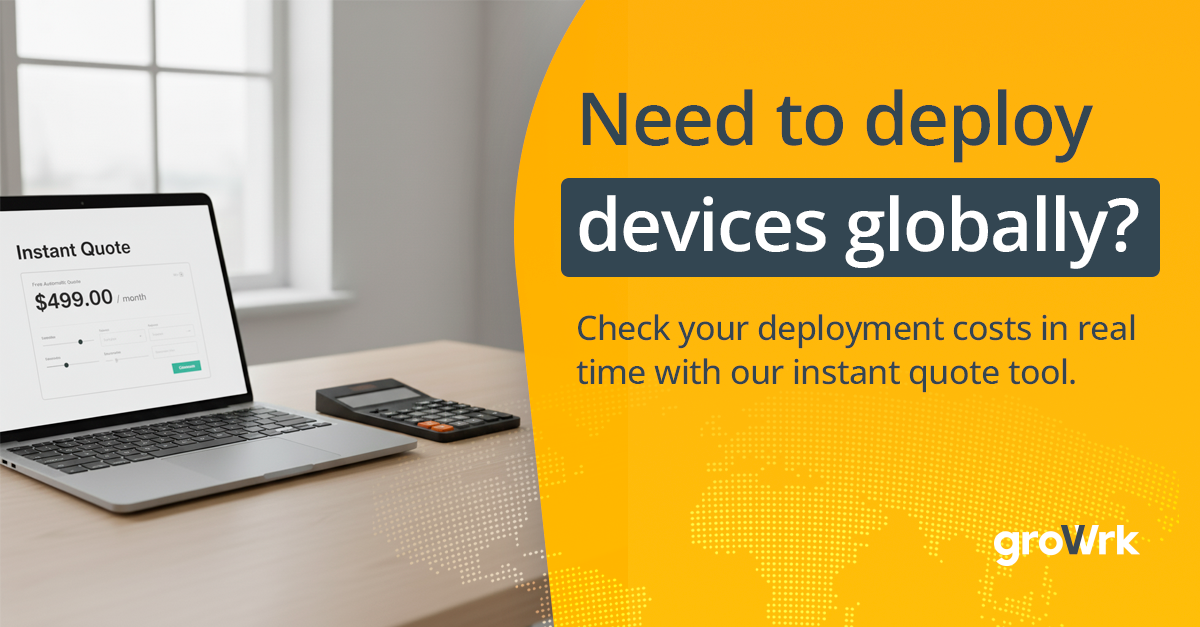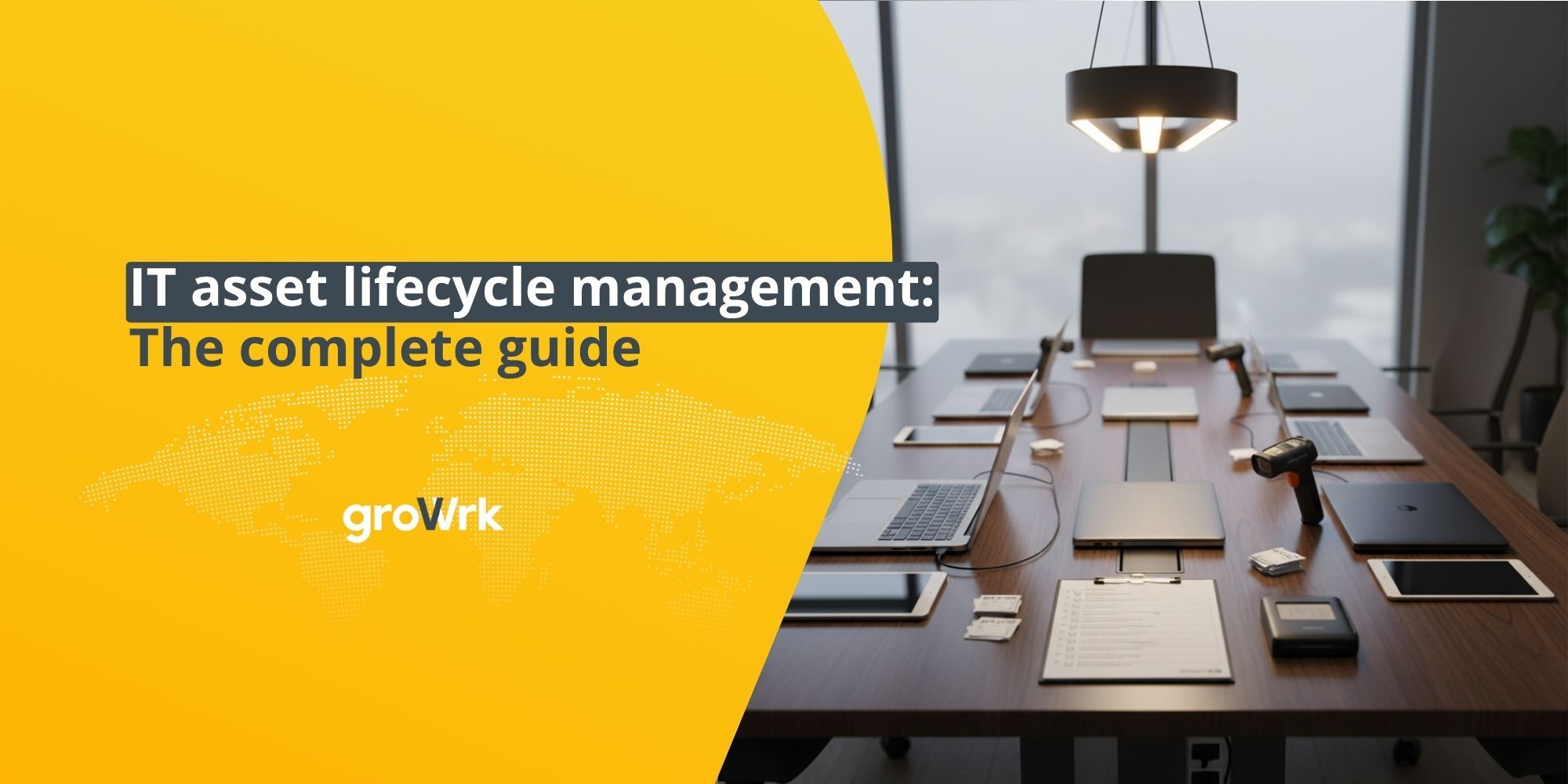IT Manager’s Guide: Choosing a Scalable Logistics Partner
 GroWrk Team
GroWrk Team
Managing IT for a distributed team means owning the end-to-end logistics of moving goods and getting devices to their intended locations, quickly and securely. As soon as you pick the wrong logistics partner, things go sideways. The shipments arrive late, assets go missing, costs skyrocket, and employees are left waiting to perform their jobs. And here’s the real eye-opener: only 6% of companies have full visibility into their supply chain.
The good news? You’re here and you’re making the right move.
Let’s walk you through this guide so you can choose the right logistics partner to fuel your growth, protect your assets, and streamline your workflows. We’ll also show you what to look for, what to avoid, and how to make a decision that will hold up as your business scales into the future.
Key takeaways
-
Choosing the right logistics partner is critical for scaling IT operations as they improve efficiency, visibility, and compliance.
-
Key evaluation factors for logistics partners are global reach, robust inventory management, flexibility, transparent pricing, seamless system integration, and effective transport solutions.
-
Avoid common red flags like limited geographic coverage, unclear service level agreements, and complex fee structures to ensure successful logistics operations.
Why does the right logistics partner matter?
Logistics isn’t just about shipping hardware in today’s distributed work environment. It’s all about powering your IT operations from behind the scenes. So if you’re managing a team that spans cities, countries, or even continents, your logistics partner isn’t just another vendor. They are an extension of your IT department. They focus on moving goods, managing cargo, and enabling growth through smart technology.
Here’s what happens when the wrong logistics partner is in place:
-
Delayed shipments slow down onboarding. New employees show up, excited to start, but don’t have the tools they need.
-
Limited stock puts your team in constant firefighting mode, scrambling to fill gaps at the last minute.
-
No retrieval workflows? You risk losing not just devices but sensitive data when employees leave.
-
Rigid, outdated logistics models prevent you from scaling efficiently, especially when entering new markets or downsizing quickly.

Sounds familiar? You’re not alone! Many of your peers are struggling with the same pain points. The reality is that a strong logistics partner helps you stay agile and competitive. They don’t just move boxes or handle freight. They help you:
-
Keep onboarding smooth and consistent, no matter where the hire is.
-
Manage inventory intelligently with visibility and control.
-
Protect company data through secure retrieval processes.
-
Scale up or down without hitting roadblocks.
So when you’re choosing a partner, look beyond shipping times and pricing. You need someone who can grow with you, plug into your systems, and make your job easier.
Get an instant quote
Common Use Cases for IT Logistics
No two companies manage IT logistics in quite the same way—but most fall into a few distinct patterns. Whether you’re a fast-scaling startup or an enterprise-level global player, your logistics needs vary based on how your teams are structured. Here are the most common IT logistics use cases today:
| Use case | Description | Logistics needs |
|---|---|---|
| Remote-first teams with scattered headcount | Teams with 1–2 employees working remotely across many regions | Individual laptop shipments, pre-configured and delivered directly to home addresses; retrieval support when offboarding |
| Global company with office hubs | Offices in multiple countries or cities, each with partial or rotating staff | Bulk shipments to hub locations, combined with individual deliveries for remote or hybrid workers; regional warehousing and support |
| Single HQ with international employees | Centralized operations with globally dispersed employees in non-HQ markets | One-off international shipments, timezone-coordinated support, localized sourcing to reduce customs delays |
| Contractor-heavy workforce | Organizations relying on short-term or project-based external staff | Flexible device leasing or re-deployment; fast turnarounds for onboarding and retrieval to control asset loss |
| High-churn environments | Businesses with frequent employee transitions due to seasonal cycles or high growth | Automated logistics tied to HR systems for seamless provisioning and recovery at scale |
Key factors to evaluate in a scalable IT logistics partner
Your company’s growing demands call for a scalable logistics ally. Selecting the best logistics provider requires close attention to several key elements.
| Evaluation factor | Why it matters | What to look for |
|---|---|---|
| Global reach & local expertise | Ensures delivery and compliance worldwide | Coverage map, customs knowledge, multilingual support |
| Inventory management | Reduces stockouts, improves visibility | Real-time dashboards, multi-warehouse support |
| Onboarding & retrieval | Speeds up productivity, protects data | Device tracking, secure pickup workflows |
| Flexibility & scalability | Supports growth or downsizing | Custom SLAs, regional coverage |
| Transparent pricing | Prevents hidden costs | Fixed fees, tiered pricing models |
| Systems integration | Reduces manual work, increases visibility | API support, ERP/MDM integrations |
Common red flags when choosing a logistics provider
.png?width=600&height=300&name=it%20managers%20guide%20choosing%20a%20scalable%20logistics%20partner%20(1).png)
Choosing the right logistics provider is about identifying the right factors and avoiding common pitfalls. Businesses must use various tools and strategies to stay competitive. Effectively using online platforms can give you valuable insights and access to essential resources and solutions that drive sales growth and innovation. So, when choosing the right logistics provider, there are some red flags to look out for.
| Red flag | Consequence | What to ask/check |
|---|---|---|
| Limited geographic coverage | Can’t scale to new markets | Ask for their country/region coverage map |
| No clear SLAs | Missed timelines, no accountability | Request example SLA docs and turnaround benchmarks |
| Poor inventory visibility | Stockouts, asset loss | Ask if they offer real-time dashboards |
| Complex fee structures | Surprise costs, hard to forecast budgets | Ask for a sample quote with pricing breakdown |
Impact of Poor Logistics on Distributed IT Operations

Why This Matters:
-
Shipping delays (88%): A significant majority of companies experience shipping delays, which can hinder timely onboarding and disrupt operations.
-
Inventory and product shortages (70%): A substantial portion of businesses face inventory challenges, leading to potential operational bottlenecks.
-
Revenue loss due to delays (60%): Delays in the supply chain can directly impact the bottom line, with many companies reporting significant revenue losses.
-
Manual or no inventory tracking (39%): Reliance on manual processes increases the risk of errors and inefficiencies in inventory management.
How GroWrk delivers scalable IT logistics
GroWrk is more than a logistics provider—it’s a global IT logistics engine built for distributed teams. From day-one onboarding to secure offboarding, GroWrk helps you deliver devices on time, stay compliant, and scale your operations seamlessly in 150+ countries.
Here’s how GroWrk supports your IT logistics at scale:
-
Global reach with local execution
Deliver and retrieve IT equipment in over 150 countries with localized logistics, tax compliance, and customs handling already built in. -
Automated logistics workflows
Eliminate manual processes with built-in automations for onboarding, device retrieval, and redeployment—triggered by your HRIS or ITSM. -
Real-time inventory visibility
Track every asset from order to recovery through a centralized dashboard with live status, location, and lifecycle insights. -
Flexible, scalable infrastructure
Whether you’re launching in a new market or downsizing a region, GroWrk adapts to your needs without added overhead. -
Secure retrieval and data protection
Built-in return workflows ensure that devices are recovered securely, wiped, and recycled or redeployed in line with your compliance policies. -
Transparent, predictable pricing
No hidden fees—GroWrk offers clear per-device pricing models that make forecasting easy and cost control predictable. -
Plug-and-play system integrations
Seamlessly connect GroWrk with your existing stack—HR, MDM, procurement, and helpdesk tools—for end-to-end process control.
Ready to streamline your logistics and scale with confidence? Schedule a demo to see GroWrk in action.
Frequently asked questions
Is logistics the backbone of scalable operations?
Yes, logistics is the foundation of scalable operations. It helps businesses manage inventory actively, streamline transport, and respond to growth and change. Without a strong logistics solution, delays, rising costs, and inefficiencies block growth. Scalable logistics keeps operations smooth and reliable for long-term success and the ability to seize new opportunities.
Why is choosing the right logistics partner so critical for IT infrastructure management?
Choosing the right logistics partner is important for IT infrastructure management. It means timely deliveries and minimizes disruptions, which is key to running efficient operations across multiple teams. This decision directly impacts the overall performance and reliability of your IT systems.
What are the key factors to consider when selecting a scalable IT logistics partner?
When selecting a scalable IT logistics partner, prioritize global reach with local expertise, robust inventory management, and flexible scalability. Make sure scalable IT logistics partners have transparent pricing and integrate seamlessly with your existing systems for maximum efficiency.
What are some common red flags to avoid when choosing a logistics provider?
The common red flags to watch out for when choosing a logistics provider are:
-
Limited geographic coverage
-
Unclear service level agreements (SLAs)
-
Poor inventory visibility
-
Complex or hidden fee structures
How does GroWrk deliver scalable IT logistics?
GroWrk delivers IT logistics with features like global reach and automated workflows so you can adapt to business growth while improving operational efficiency and reducing costs. This means logistics runs smoothly and is responsive to changing demands.
Why should I talk to IT logistics experts at GroWrk?
Talking to IT logistics experts at GroWrk is key to designing a logistics strategy that fits your growth goals. It means efficient and scalable operations that support long-term business success. Plus, it has a big impact on your logistics efficiency.




.png)

